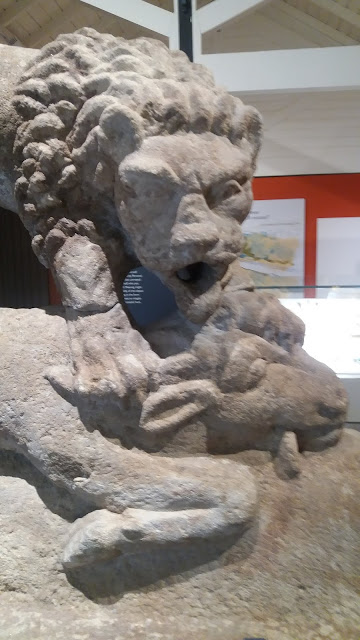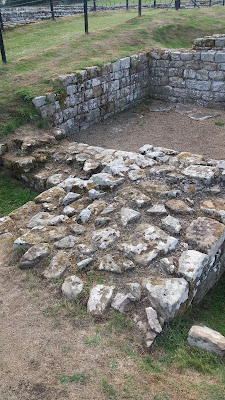Every holiday my husband makes me walk for many hours around the cities and towns of our destination. Under no circumstances can we take a taxi. I get very footsore and it is much worse when the weather is hot. This year I am prepared for long walks and I chose a cold destination, Hadrian's wall in the North of England.
I really wanted to drive around looking at railway lines and other industrial archaeology, throwing in a day's walking on Hadrian's Wall path and looking at Roman camps such as Housesteads. But the Man in my Life decided we should take the train to the East end of the wall (Newcastle) and walk to the West end, and take the train back from Carlisle. We should walk the WHOLE THING.
He also thought we could carry our stuff in backpacks, so we took very little stuff.
First day - Wallsend to Newcastle - You start at the Segundum fort, and look at the remains of the Roman camp. There were 16 camps on the wall and this looked like a small one. It is right next to the now extinct shipyards. I was very sorry indeed to look at the complete lack of industry in Newcastle.
 |
| deserted buildings |
 |
| The Roman camp partly exposed. |
The museum was quite helpful, telling us from how far afield the soldiers came to man the wall. There was only one British troop. The rest came from many different areas of Europe and Asia. There were even troops from Syria and Iran.
It seems that Roman soldiers wore shoes and socks. I was pleased. How could they bear the cold of Up North with their little sandals?
The path was entirely on the flat, next to the river Tyne and there were many information boards to look at telling about the industries that were there. Terrible industries like treating lead ore, leather working and most noxious of all, making coal tar products like creosote, pitch and tar. The last industry caused such pollution that an entire embankment had to be built to stop the polluted earth seeping pollutants into the Tyne. It was a hell of a job but it has been done and the river is clean, and now there are flats and small houses built along there - and many more will come. The tide was out as we walked along. There were rows of tires in the mud and there were a couple of people digging in them. I asked what they were doing and they said digging for crabs to use as bait. A few people were fishing with long rods - the tide was out.
Once we reached the city we postponed the walk because there were things to see in the city - sadly I did not see, for example, the art gallery, but we did see the "Rocket" - the locomotive engine which won the Rainhill trials in 1829 and convinced the engineers watching that locomotive steam engines were the future. This machine is on display in the Discovery museum, which is in the old Co-operative building. It is hard to know whether any of the iron or brass parts are the originals. The wheels are wooden - probably original. The buffer is wooden! The design was re-worked by Stephenson so the pistons were lower, and we were looking at the original configuration. I think this artifact is not really the original Rocket. There was a display of pictures and documents with the Rocket which was very interesting. Especially - how soon Stephenson was able to design and build a much better engine! I think the science museum has exchanged this exhibit for the "Puffing Billy", which was the first locomotive engine, probably, and was used at Wylam colliery of which, more later.
 |
| The Rocket's wheels were made of pine |
There was an old Merchant's house which was very impressive, and an old pub next door - walking is thirsty work. We also saw the castle and looked at the renovated double-decker bridge designed by Stephenson - the High Level bridge, it's called. Much original ironwork in it, I understand, but now has been put together more strongly. We also looked at the art (not impressive) in the Baltic building (impressive) and took a picture of the new bridge (beautiful and clever).
 |
| This entire bridge tilts, allowing river traffic underneath. |
Day 2 - walk from Newcastle to Heddon on the Wall.
This walk started from the middle of town and we were carrying all our luggage on our backs. I admired Newcastle very much. What gorgeous Whig buildings! and a column to Lord Grey for passing the Reform Act of 1832!
 |
| Theatre, Newcastle |
The walk stayed flat as we walked by the Tyne, where we saw some old coal staithes. The point of these was to load ships with coal when the tide was low. Here is a graphic showing the wagons on the staithes.

and then we had to leave the river to go through a country park, eventually returned to the river and enjoyed leaving the city behind. At this point the walkers share the path with a lot of cyclists which could be annoying. We walked several miles and eventually came to the Wylam waggonway, where coal was taken to the staithes a few miles away. This was the place the first steam engine was developed - the Puffing Billy. I have looked it up in the Science Museum website and it was not invented by George Stephenson, but he would definitely have seen it as a young man. The cottage where he lived as a boy was a bit further on, on our route, so we made the effort to see it. It is owned by the National Trust but is not open to the public. In the 18th century four families lived in this modest cottage. They can't have had much space nor any privacy. The men and boys would have been miners.

Dating to 1813-1814, Puffing Billy was built by William Hedley, Jonathan Forster, and Timothy Hackworth, for use at the Wylam Colliery near Newcastle-Upon-Tyne.
Built to replace the horses used on the tramway, Puffing Billy was one of three engines built by Hedley, the resident engineer at the colliery. It remained in service at the colliery until 1862, when it was lent to the Patent Office Museum in South Kensington, which became the Science Museum.
 |
| Puffing Billy |
It's basically two beam engines working alternately. I think.
After this we had to climb a steep hill by a golf course to Heddon on the Wall, where we found a delightful tea room and we deserved some cake, certainly! We stayed that night in a farm outbuilding which had been converted for walkers. We had the room that was adapted for the disabled, so we had a bath room to ourselves, and we slept in bunk beds - they were hard.



































